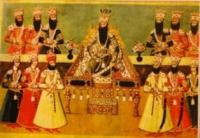You are here
Antigue Samarkand.

Visit to Uzbekistan.
“If diversity is a source of wonder, its opposite - the ubiquitous condensation to some blandly amorphous and singulary generic modern culture that takes for granted an impoverished environment - is a source of dismay. There is, indeed, a fire burning over the earth, taking with it plants and animals, cultures, languages, ancient skills and visionary wisdom. Quelling this flame, and re-inventing the poetry of diversity is perhaps the most importent challenge of our times”
Wade Davis.
The History Uzbekistan - Silk Road Adventures.
One of the most ancient cities under the sun, Samarkand is situated deep in the Central Asian interfluve. This is an area between the Amu Darya and Syr Darya, known as Transoxiana or Maverannahr.
The city is coeval with ancient Rome and has more, than 2500-year history. Destiny of many outstanding politicians and commanders was connected with Samarkand: Alexander the Great and Ismail Samani, Sultan Sandjar and Chinggis-khan, Amir Temur and Babur.
Samarkand’s architectural and archaeological treasury was included in UNESCO’s register of the World Heritage. The ancient city is located in the Zerafshan oasis, inhabited from the upper Palaeolithic period (between 40 and 15 thousand B.C.).
Numerous Mesolithic and Neolithic sites, as well as sites of the Bronze Age were revealed around the city. In the IIIrd – IInd thousand B.C., the Zerafshan valley became one of the centers of Indo-Iranian civilization.
At the shift of the IInd - Ist thousand B.C., the Eastern - Iranian tribes settled down here for good, as well as in the other Central Asia oases. The first centuries of the first thousand B.C. were marked by a significant cultural event - sermons of Zoroaster and creation of sacred Zoroastrian book "Avesta".
The ancient Iranian legends say that Samarkand was founded by Kavus, the second king from the Kavianid dynasty. In days of Kavus’s son, Siyavush, the city was extended, and his grandson Qai-Khusraw transferred the Fire Altar to Samarkand.
Zoroaster started preaching here. According to the epic legends, Siyavush was killed by Turanian king, the Sakae chief, Afrasiab, whose name was given to the ancient hill in Samarkand.
At the shift of the VIIth – VIIth centuries B.C., in the lands between the Syr-Darya and Amu Darya, the proto-urban culture was forming. Large state federations arose in Bactria and Khorezm, which contacted Assyria, New Babylon and Indian principalities.
Sogdiana (Sogd), including valleys of the Zerafshan and Kashka Darya rivers, was a part of ancient Bactria. The sources inform that the Bactrian kingdom became a target of Assyrian aggressive policy and finally was subordinated to Assyria.
In the war between Media and Assyria, the Bactrians crossed over to Media. In the middle of the 6th century B.C., the Persians, having founded the great Achaemenid empire, defeated the Median kingdom.
Though the Persian king, Cyrus fell in the steppes of Central Asia, at the last third of the VIth century B.C., Sogdiana was integrated in the Achaemenid empire. Alongside with Khorezm and Parthia, it formed Satrapy XVI .
The majority of scholars identify the capital of Sogdiana - Marakanda with ancient Samarkand. In the VIIIth - early VIIth centuries B.C., the separate settlements on the Afrasiab hill were encircled by common defensive line.
This settlement occupied more than 200 hectares in a form of a triangle. Bluffs of Siab’s and Obi-Mugon’s anabranches protected it in the north and east, and deep ravines - in the south and west.
In the Achaemenid period, the city was encircled by a new massive wall with internal corridor and towers. The citadel with satrap’s palace was additionally fortified. Dwelling and industrial quarters alternated with extensive barrens, squares and hauzes (water reservoirs).
Authority:
Alexey Arapov. Samarkand. Masterpieces of Central Asia. Tashkent, Sanat. 2004.







